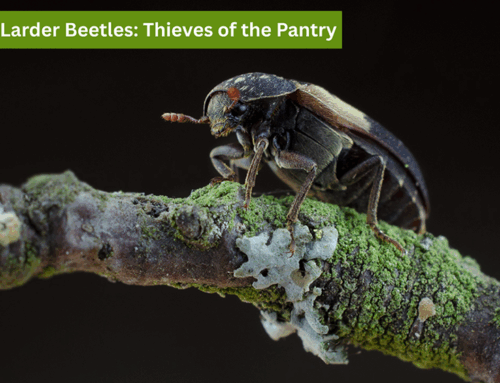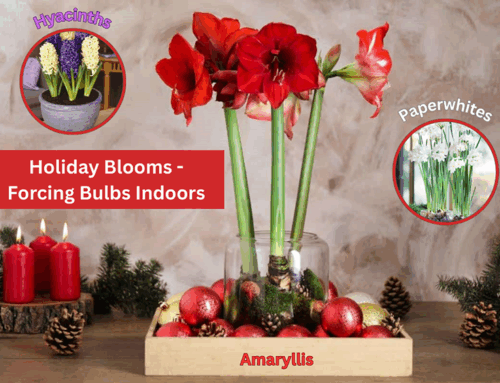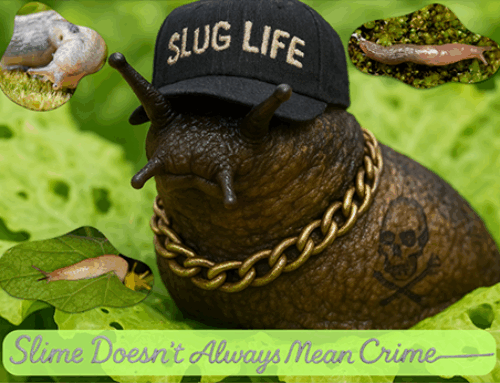Spring Flowers That Can’t Wait for Warmth (Part 2)
by Brett Kerley
As the snow begins to melt and the days grow longer, gardeners in Edmonton eagerly anticipate the first signs of spring. While this region experiences harsh winters, there are several resilient plants that emerge early, bringing color and life to the landscape. From delicate crocuses pushing through the last patches of snow to hardy perennials that thrive in cool temperatures, these early bloomers set the stage for the growing season ahead. In this second part of the article, we’ll explore 5 more of the best plants for early spring in Zone 4, helping you create a vibrant and resilient garden that awakens with the first warmth of the season.
Daffodils
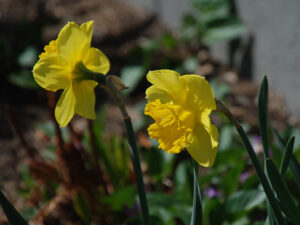 Scientific Name: Narcissus spp.
Scientific Name: Narcissus spp.
Common Names: Daffodil, jonquil, narcissus, paperwhite
Family: Amaryllidaceae (Amaryllis family)
Native Range: Europe, North Africa, and western Asia.
Type: Perennial bulbous plants
Size: Height ranges from 6–20 inches (15–50 cm), depending on the species or cultivar.Bloom Time: Early to mid-spring
Why They’re Great: These iconic spring flowers are vibrant and hardy, with trumpet-shaped blooms in yellow, white, or orange. They’re also pest-resistant.
Care Tips
- Planting: Plant bulbs in the fall, 3–6 inches deep and spaced 4–6 inches apart, with the pointed side facing up.
- Watering: Water after planting and during active growth, but avoid overwatering when dormant.
- Deadheading: Remove spent flowers to prevent energy from going to seed production, but leave the leaves to die back naturally to feed the bulb.
- Fertilizer: Apply a balanced, slow-release fertilizer when the leaves emerge in spring.
- Division: Divide overcrowded clumps every 3–5 years to maintain vigor.
Interesting Facts
- Cold Hardy: Daffodils are hardy and can tolerate frosts, often blooming even when the ground is still cold.
- Toxicity: All parts of the plant are toxic if ingested, containing alkaloids that can cause nausea, vomiting, and abdominal pain.
- Deer and Rodent Resistant: Their toxicity makes them unappealing to deer, rabbits, and rodents, making them a reliable garden plant.
- Symbolism: Daffodils symbolize rebirth, renewal, and the arrival of spring. In some cultures, they are considered a symbol of good luck and prosperity.
- Variety: There are about 50 species of Narcissus and thousands of hybrids and cultivars. These are divided into 13 horticultural divisions based on flower form and characteristics.
- Naturalizing: Daffodils naturalize easily, spreading and returning year after year with minimal care.
- Paperwhites: Narcissus papyraceus, commonly known as paperwhites, is a popular species grown indoors for its fragrant, winter-blooming flowers.
Glory-of-the-Snow
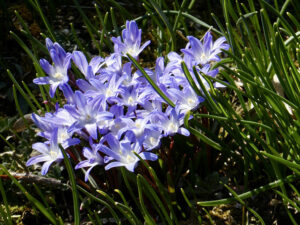 Scientific Name: Chionodoxa spp.
Scientific Name: Chionodoxa spp.
Common Name: Glory-of-the-Snow
Family: Asparagaceae (formerly in Liliaceae)
Native Range: Native to the eastern Mediterranean region, including Turkey, Crete, and Cyprus.
Type: Perennial bulbous plant
Size: Typically grows 4–6 inches (10–15 cm) tall.
Bloom Time: Early spring
Why They’re Great: True to their name, Glory-of-the-Snow blooms while snow is still on the ground. These small star-shaped flowers come in shades of blue, white, and pink.
Care Tips
- Planting: Plant bulbs in the fall, 2–3 inches deep and 3–4 inches apart, in clusters for the best display.
- Watering: Requires little water once established; ensure soil is not waterlogged.
- Low Maintenance: Does not require frequent care; foliage should be left to die back naturally after blooming to replenish the bulb.
- Fertilizer: Apply a light bulb fertilizer in the fall or early spring to encourage healthy blooms.
- Pest Resistance: Resistant to deer, rabbits, and squirrels due to their natural unpalatability.
Interesting Facts
- Name Meaning: The genus name Chionodoxa comes from the Greek words chion (snow) and doxa (glory), referring to its ability to bloom in snowy conditions.
- Naturalizing Ability: These bulbs multiply rapidly by offsets and self-seeding, creating colorful carpets over time.
- Cold Hardy: Extremely cold-tolerant and able to bloom in areas with harsh winters.
- Pollinator-Friendly: Provides an early source of nectar and pollen for bees and other pollinators emerging in spring.
- Toxicity: Non-toxic to humans and animals, making it safe for gardens with pets.
- Variety: There are several species within the genus, including Chionodoxa luciliae and Chionodoxa sardensis, which differ slightly in size and flower color intensity.
Grape Hyacinth
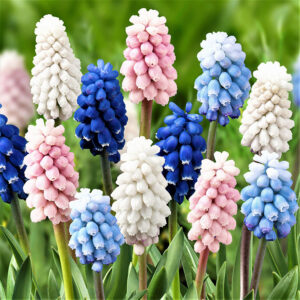 Scientific Name: Muscari spp.
Scientific Name: Muscari spp.
Common Names: Grape hyacinths, bluebells (not to be confused with true bluebells), baby’s breath.
Family: Asparagaceae (formerly Hyacinthaceae).
Native Range: Native to Eurasia, particularly the Mediterranean region, the Caucasus, and parts of western Asia.
Type: Perennial bulbous plants.
Size: Typically grows 6–12 inches (15–30 cm) tall.
Bloom Time: Early to mid-spring
Why They’re Great: Grape hyacinths produce clusters of tiny, bell-shaped flowers that resemble bunches of grapes. Their fragrance and rich blue color make them a standout.
Care Tips
- Planting: Plant bulbs in the fall, 2–3 inches deep and 2–3 inches apart, in clusters for the best effect.
- Watering: Requires minimal watering; water sparingly during the growing season and not at all during dormancy.
- Fertilizer: Apply a balanced, slow-release fertilizer in early spring to boost blooms.
- Maintenance: Low maintenance; allow the foliage to die back naturally after blooming to feed the bulbs.
- Division: Divide clumps every 3–4 years if they become overcrowded.
Interesting Facts
- Name Meaning: The name Muscari comes from the Greek word “muschos,” meaning musk, due to the faint musky scent of the flowers.
- Naturalizing Ability: Grape hyacinths are prolific naturalizers, spreading easily through bulb offsets and seeds, creating colorful carpets over time.
- Cold Hardy: Very cold-tolerant, making them ideal for early spring gardens in cooler climates.
- Color Variety: While blue is the most common color, some species and cultivars come in shades of purple, white, and even bi-colored varieties.
- Pollinator-Friendly: The flowers provide an important source of nectar for bees and other early pollinators.
- Fragrance: Certain species, like Muscari armeniacum, have a sweet, grape-like scent.
- Non-Toxic: Unlike many other bulbs, Muscari spp. is considered safe and non-toxic to humans and pets.
Pasque Flower
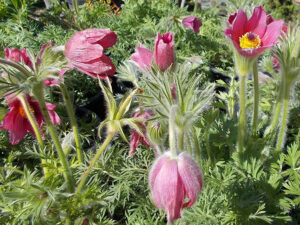 Scientific Name: Pulsatilla vulgaris
Scientific Name: Pulsatilla vulgaris
Common Names: Pasque flower, pasqueflower, windflower, meadow anemone
Family: Ranunculaceae (Buttercup family)
Native Range: Europe, including the UK, France, Germany, and parts of Scandinavia.
Type: Herbaceous perennial
Size: Typically grows 6–12 inches (15–30 cm) tall and wide.
Bloom Time: Early to mid-spring
Why They’re Great: This native prairie flower has fuzzy stems and stunning purple, bell-shaped blooms. It’s a hardy perennial that thrives in cold climates.
Care Tips
- Planting: Best planted in the fall or early spring; space plants 12–18 inches apart to allow for growth.
- Watering: Requires minimal watering; drought-tolerant once established. Avoid overwatering, as the plant dislikes wet soils.
- Pruning: Remove spent flower stems to encourage a tidy appearance, but leave seed heads if you enjoy their ornamental value.
- Fertilizer: Does not require heavy feeding; a light application of balanced fertilizer in early spring is sufficient.
- Division: Rarely needs division, but can be divided in early autumn if necessary.
Interesting Facts
- Name Origin: The name “Pasque flower” is derived from the French word Pâques, meaning Easter, as it typically blooms around that time.
- Silky Appearance: The plant is covered in soft, silvery hairs, which help protect it from cold and drying winds.
- Symbolism: In folklore, the Pasque flower is associated with spring, renewal, and rebirth.
- Wildflower Status: In the UK, Pulsatilla vulgaris is a rare and protected wildflower found in chalky grasslands.
- Medicinal Uses: Historically used in herbal medicine as a sedative, though it is toxic and must be handled with caution.
- Toxicity: All parts of the plant are toxic if ingested, containing compounds that can irritate the skin and mucous membranes.
- Pollinator-Friendly: The flowers attract early pollinators such as bees and other insects emerging in spring.
Lungwort
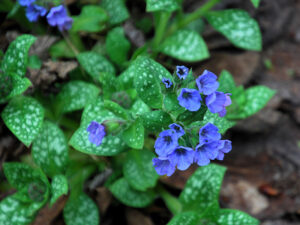 Scientific Name: Pulmonaria spp.
Scientific Name: Pulmonaria spp.
Common Names: Lungwort, Bethlehem sage, spotted dog, soldiers-and-sailors.
Family: Boraginaceae (Borage family).
Native Range: Europe and western Asia, often found in woodland areas.
Type: Herbaceous perennial.
Size: Grows 8–18 inches (20–45 cm) tall and 12–24 inches (30–60 cm) wide, depending on the species or cultivar.
Bloom Time: Early to mid-spring
Why They’re Great: Lungwort is a low-growing perennial with unique spotted foliage and clusters of flowers that change color as they mature.
Care Tips
- Planting: Plant in early spring or fall, spacing clumps 12–18 inches apart.
- Watering: Keep soil consistently moist, especially during dry periods, but avoid waterlogged conditions.
- Mulching: Apply organic mulch to retain moisture and suppress weeds.
- Pruning: Remove spent flowers and old, damaged leaves to encourage fresh growth.
- Division: Divide clumps every 3–5 years in early spring or fall to maintain vigor.
Interesting Facts
- Name Origin: The name “Lungwort” derives from the Latin pulmo (lung), as the spotted leaves were thought to resemble diseased lungs. This led to its historical use in folk medicine for treating respiratory ailments.
- Color-Changing Flowers: The flowers shift color as they age due to changes in pH levels within the petals—pink for acidic and blue for more alkaline conditions.
- Pollinator Magnet: The blooms are highly attractive to early pollinators like bees and bumblebees.
- Cold Tolerant: Lungwort is highly tolerant of cold weather and can handle early spring frosts.
- Deer and Rabbit Resistant: The hairy leaves deter deer and rabbits, making it a good choice for wildlife-prone gardens.
- Variety: There are about 15 species of Pulmonaria, along with numerous hybrids and cultivars, offering a wide range of flower and foliage colors.
- Shade Gardening: One of the best perennials for shady or woodland gardens, thriving where many other plants struggle.
Final Thoughts to Consider
- Plan Ahead: Most early spring flowers are planted in the fall, so plan your garden in advance.
- Amend Soil: Ensure your soil is rich and well-drained. Adding compost improves soil health and drainage.
- Mulch: Apply mulch in late fall to protect bulbs from freezing temperatures and to suppress weeds in early spring.
- Consider Pollinators: Many of these flowers are excellent for early pollinators like bees.
Adding these hardy early bloomers to your Zone 4 garden ensures a burst of color and life as winter fades. Which ones will you plant this year?
Happy Gardening Everyone!





